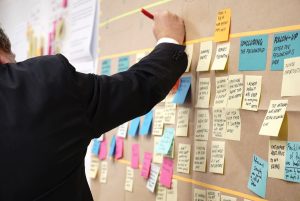Kaizen Method: what it is and how to apply it in business and self-development

The term Kaizen came from Japan. After the Second World War, against the background of the oil crisis, Western companies were making losses, while production in Japan was flourishing. This was possible thanks to the introduction of the Kaizen management system based on the growth of both the individual and the whole team.
Author of the idea is Masaaki Imai, the founder of the concept of continuous improvement. “Continuous improvement” is the translation of the word Kaizen, but there are other interpretations. According to this system, the process of improvement involves everyone from workers to managers. Kaizen philosophy suggests that our personal and working lives should follow a vector of constant and continuous improvement.
Basic Principles
- Self-discipline is the key to moving forward. Every employee should be able to manage his time, not to miss deadlines, to monitor the quality of work and to use resources with care.
- Moral spirit. Management needs to maintain the morale of employees regardless of their successes. Comfortable working conditions, material rewards, and a social package are the most important components of a successful business.
- Teamwork. Working together for the common good. Brainstorming groups are encouraged where participants share experiences and ideas. Employee development is encouraged and the company endeavors to pay for them.
- Openness. All discussions are conducted publicly, online or in meetings. No behind-the-scenes intrigue or gossip. The same applies to customer relations – be honest about the state of the company’s affairs and don’t sugarcoat the reality.
- Continuity of change. The Kaizen method requires continuous change in the company. It is possible to inject new personnel to replace those who have left. The main thing is that the colleagues who came to the company should share a common philosophy. The company can even abandon regulations if they interfere with the development of production.
- Employee suggestions. Every team member can and should make suggestions to improve the work process. The management, for its part, considers all suggestions, even seemingly ridiculous ones.

Kaizen and the 5S methodology
5S is a workplace organization and rationalization methodology that aims to increase the efficiency and organization of an industrial area, increase productivity, save time and improve corporate culture.
It is named from the first letters of Japanese words:
- Seiri (sorting) – labelling of elements and identification of unwanted elements. Items that are not needed are removed from the production process.
- Seiton (systematization) – maintaining order in the workplace. All equipment and tools must be in their places and accessible.
- Seiso (keep clean) – all the necessary tools must be kept clean. After finishing work, they must be put back and kept in order.
- Seiketsu (standardization) – the three points above should become the norm in work. It is important that the employee sees the effect of following the rules. This should stimulate labor productivity.
- Shitsuke (improvement) – established practices should be continuously maintained. The workplace should be monitored and standardized.

How to implement Kaizen in business
You should start by implementing the PDCA cycle. Plan-do-control-act means plan – act – check – improve. What to do in this cycle?
- Plan. Think through and make a plan for the development of the production. Study all the introductory components.
- Do. Implement the plan.
- Test. Draw conclusions about the effectiveness of the hypotheses tested.
- Improve. Solidify the positive results achieved.
The PDCA cycle is then repeated.
To make the Kaizen system work, create so-called Kaizen teams. Their tasks are divided into 5 groups:
- Permanent Teams. Teams of workers and employees working daily on tasks in the field.
- Problem-solving teams. Formed of 6-8 people to solve a sudden problem. At the end of the work, the team is disbanded.
- Cross-functional teams. Teams that assess the production situation and look for ways to improve it. They are made up of rank-and-file employees and management representatives.
- Solution Implementation Teams. These are groups to implement the proposed ideas. They consist of members of the previous two teams.
- Small groups. Established to plan, develop and implement specific untried ideas.
The key point of the Kaizen method is ideas from employees. The main thing is that ideas should not be put forward to tick a box, but should reach the management and be considered. Even if they seem absurd at first glance. Face-to-face meetings or chat rooms can be used to exchange ideas, or just a special box to collect messages;
It is important to give feedback on every suggestion. Employees should feel that their ideas are important and needed by the company. It is better if the response period is regulated by internal regulations and the response itself is in writing.
For kaizen proposals, there should be bonuses or prizes for participation. However, they should not be substantial, as large sums will encourage ideas to be submitted on a commercial basis. Bonuses should also not be tied to actual savings from the introduction of an idea. We reward employee achievement and discourage mercantilism.
To ensure that the process of improving the work of the company is continuous, it is necessary to summarize each proposal. Employees need to see that their ideas are not being “put in the back of their minds” and that they are interested in them. This will reinforce motivation.

How to use Kaizen for personal growth
Move forward towards your goal, but in small steps, gradually. It is easier to stick to what you have planned without making huge efforts. And over time, you can gradually increase the pace. A small task solved will bring more benefit than a grandiose, but left in the plans. Look at the difference in messages:
- I’ll learn French in three months.
I will learn 10 new words every day.
- I’m going to lose 5kg by New Year’s Eve.
I’m going to put half as much sugar in my tea.
- I’m going to start getting up at 5am and doing some exercise.
I’ll get up 10 mins early so I can do my warm-up.
Think about it, which promise are you more likely to keep? Probably the one that doesn’t require a whole upheaval in your routine. Instead of constantly reminding yourself of what you must do or achieve, psychologists suggest asking the questions. “What can I do today to improve my life?”. This will help you identify where the problem lies and avoid forcing yourself. Commanding yourself often doesn’t work and only causes guilt.
To achieve improvements, it is enough to follow simple rules;
But always start with small steps.
- If you make a mistake, correct it immediately
You are bound to stumble on your way, but the road is for the one who walks it. Do not let failures turn into disappointments. If you make a mistake, correct it immediately. Otherwise, mistakes will pull guilt behind them. No one is perfect.
- Do it!
If you read a cake recipe a hundred times, you won’t eat it. You learn by doing. Genchi Gembutsu is Japanese for “Exit the building”. Leave your doubts behind and maximize your results.
- Don’t blame the environment
We carry the genes laid down by our parents, receive education and socialize in a community. These factors can carry both positive and negative feedback. You can blame a bad environment or an unfavorable heredity, but that goes against Kaizen. Forgive your past and move forward.
- Tame the fear
As a rule, we are afraid of what we should not be afraid of. Use fear as a compass that shows you what you can improve. If you’re afraid:
- a conversation with a supervisor
- public speeches
- of separation from parents
- dating
- old ages
- opinions of others
- own mistakes
These are irrational fears and the compass shows that they can and should be overcome.
Kaizen is infinite
Kaizen is continuous and endless. Whether applied to business or personal growth, there is no point at which a goal is reached and you can stop. Its essence is a continuous chain of improvements.
What would happen if they stopped making new iPhone models? That’s right, sales would stop. That is why Kaizen cannot be implemented once and stopped. You can adopt it, understand it and live by it.



